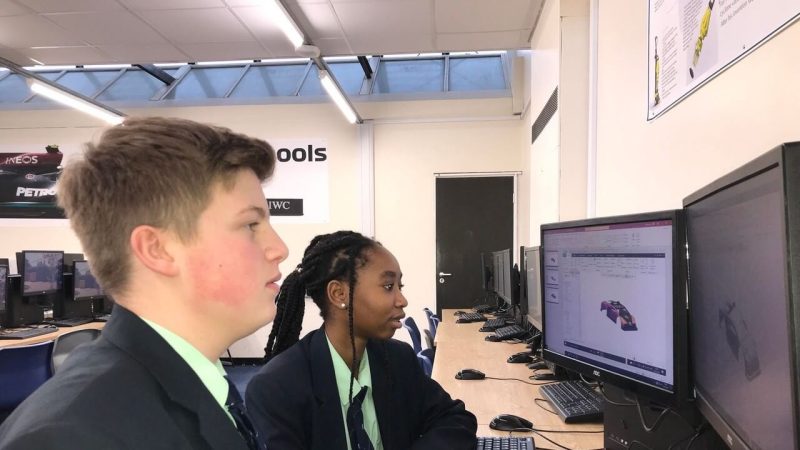Design and technology – A subject in terminal decline?

Tony Ryan reflects on whether radical reforms can save the ailing subject of design and technology from curricular extinction…
- by Tony Ryan

The UK was the first country in the world to make design and technology part of its national education curriculum. It had a clear vision – to prepare young people to become vital and confident contributors to an increasingly technological world.
At its peak in the early 2000s, over 430,000 students studied D&T at GCSE and 30,000 at A Level. I was a young head of department at a high achieving girls’ school in London at the time. Thanks to its fusion of creativity and problem-solving, many enthusiastically engaged with the subject and that passion translated into performance.
Parents embraced the futuristic nature of our curriculum too. However, our achievements at the school weren’t that far from the norm, as the subject rapidly embedded itself within schools across the country.
Since then, those figures have dwindled to 78,000 GCSE entrants and 10,000 at A Level. In 2009, there were still 14,800 trained and qualified D&T teachers. Now there are fewer than 7,000. Estimates say that the subject is approximately four years away from extinction.
Misconceptions and snobbery
In December 2023, the House of Lords’ Education for 11–16 Year Olds Committee released a report. This examined whether the UK education system was doing enough to equip young people with the skills needed to enter a fast-changing world of endless digital information and rapidly evolving AI technologies. Its conclusion? A firm ‘no’.
The report’s findings should have been a galvanising force for urgent reform. However, 2024’s general election campaigns are set to be dominated by immigration, the economy and NHS reforms, with education receiving little attention.
Yet it’s the latter that will do most to shape the national workforce of tomorrow. In turn, this will determine how well the country will fare in an increasingly volatile world.
Misconceptions around the integrity of vocational courses; subject snobbery; stringent measurements of academic performance that relegate creative disciplines to the sidelines; ever-shrinking school budgets – all these have contributed to the subject’s steady demise. Though there’s more at issue than ‘just’ a subject slowly dying. There are implications here for the UK’s competitive positioning as a global leader in innovation.
The ‘hobby subject’ myth
There’s a social problem – perhaps unique to this country – that deems certain subjects, such as D&T, as being inherently inferior. The term ‘vocational’ is heavily loaded. It often carries with it negative connotations of ‘manual’, ‘low-paid’ and ‘non-cerebral’ activity and work.
Think back to last year’s governmental pledge to crack down on so-called ‘rip-off degrees’. These are courses that allegedly provide poor employment prospects for graduates.
While ministers carefully avoided defining exactly what constituted such ‘Mickey Mouse’ courses, the inference was clear: anything deviating from traditional academic disciplines isn’t useful in today’s economy.
And yet, D&T is a great social equaliser. I speak from personal experience, as a one-time young boy from a working class background who didn’t see the point of school, but did eventually see the relevance of D&T to the reality I experienced outside of school. For me, at least, It helped put elements of science, maths and art into a real-life context. We’re now in danger of creative courses becoming the sole preserve of the privileged.
Persistent misconceptions have also fuelled a teacher shortage that’s approaching critical levels. Headteachers – many desperately wanting to see D&T thrive in their schools – are unable to find suitable staff for their departments.
Accountability – but for whom?
Headteachers have to pay close attention to those areas where they’re measured. However, adoption of the EBacc and Progress 8 have damaged the creative subjects.
Scores become paramount, but where creative subjects may only count once towards the overall school achievement score – no matter how many creative subjects you offer – these receive less attention or schools drop them entirely from their offer.
I don’t believe any Minister has purposefully set out to kill creative subjects, but by ideologically fixating on a small number of traditionally academic subjects, and deeming them to be more important than those they unhelpfully label ‘hobby subjects’, that eventuality may come to pass as a sad by-product.
Then there’s the fact that D&T provision is approximately four times as expensive than predominantly ‘book-based’ subjects like history. Even small D&T departments require machinery and raw materials if they’re to teach the subject effectively.
We can do much to reduce these costs. I’d argue that we don’t necessarily need to spend departmental fortunes for a highly effective D&T offer. But when taking into account the other points outlined above, the expense issue can easily become the deciding factor for an SLT.
Keeping up with the times
The final factor to consider when examining the subject’s demise is our inability to keep up with the pace of change. In 2017, our subject took a huge step into the relative unknown when the syllabi, subject content and general philosophy for D&T changed, alongside the introduction of new assessment methodologies.
We expected teachers to run with these changes, often with little to no training, but still with results-based accountability weighing heavy on their shoulders, and few managed the transition successfully. Many students, understandably, opted to pursue alternative qualifications that entailed less core content and no written final examinations.
However, it’s interesting to observe that while D&T provision in state schools is in national decline, it’s arguably never been healthier in the private sector, where fee-paying parents view it as an essential part of the curriculum.
Private schools, of course, have the capacity to attract more talented teachers and employ them in departments where budgets rarely prove problematic, unencumbered by the kind of qualification restrictions that state schools have to manage. If we continue on this trajectory, without urgent intervention, we’ll soon only be offering D&T within select schools.
What does the future hold?
The economic case for D&T to be taught in schools is clear. Government must work with industry to resolve the issues that threaten the subject’s future.
The good news is that change is happening. Following an extensive national consultation process with teachers and sector leaders over the last two years, the Design and Technology Association’s 2023 ‘Reimagining Design & Technology’ report set out a refined vision for its future.
The subject is currently bucking national trends at primary level, but it’s at the critical KS3 where change is most needed. We at the Design and Technology Association are currently looking to assist teachers in changing the pedagogy at their schools, by encouraging a greater emphasis on problem-solving and using design methodologies to tackle real-world problems.
We’re also looking to promote an increased focus on the green economy, circularity and the importance of design in solving Global Sustainability Goals, and seeing that these are added to the KS1 and KS2 National Curriculum.
Inspired by Industry
Businesses such as Mamas & Papas and Scalextric are among many brands that have contributed to our Inspired By Industry initiative, which is developing educational materials to show how ‘design thinking’ is being used to conceive of products, thus enabling students to respond to real design briefs set within actual industries and workplaces.
Teachers are meanwhile receiving subsidised training on how to implement this, helping to lay the pathway for curricular activity that will rejuvenate the discipline and finally measure other impacts – including student engagement, parental perception and teacher confidence – rather than just academic progress alone.
There’s still much to be done, but also good reason to be optimistic about the future of D&T. We want to continue producing the problem-solvers, innovators, creatives, designers, and thinkers of the future. Isn’t that a vision that we can surely all get behind?
Tony Ryan is chief executive officer of the Design and Technology Association; for more information, visit designtechnology.org.uk or follow @dtassoc











